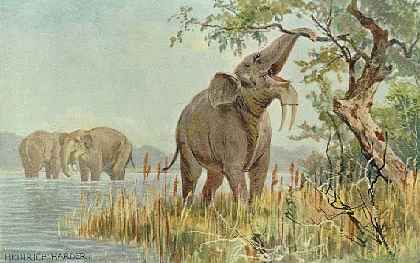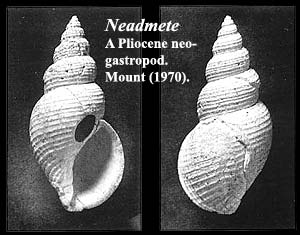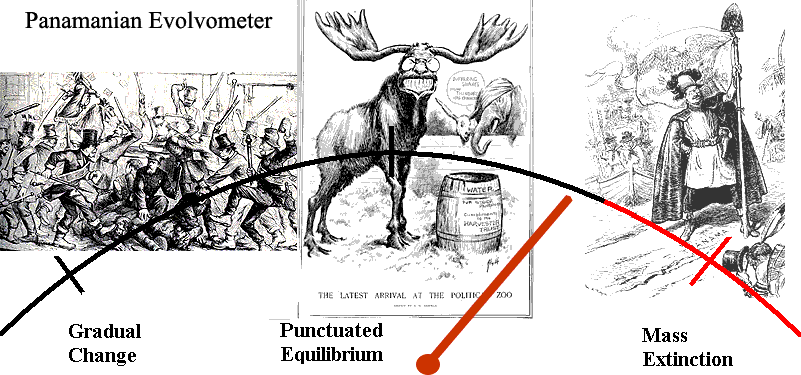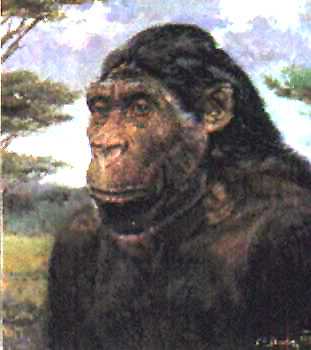| Palaeos: Cenozoic |  |
Neogene Period |
| CENOZOIC ERA | Pliocene |
| Page Back | Back: Miocene | Back: Paleogene | Up: Neogene | Unit Home |
| Page Next | Next: Pleistocene | Down: Zanclean | Time |
| Palaeos: Cenozoic |  |
Neogene Period |
| CENOZOIC ERA | Pliocene |
| Page Back | Back: Miocene | Back: Paleogene | Up: Neogene | Unit Home |
| Page Next | Next: Pleistocene | Down: Zanclean | Time |
|
Neogene
Miocene Pliocene Zanclean Piacenzian Gelasian Pleistocene Holocene |
Geology Stratigraphy Climate Life Mollusks Vertebrates References Links |

The name Pliocene means "more recent", and this was the most recent epoch of Tertiary period, lasting from about 5 to 2 million years ago. Compared to previous epochs this was a relatively brief period, "only" 3 million years. During this time the world became much more like it is today, with ice caps, modern mammals, relatively modern geography, and the evolution of prehistoric man ("ape man").
By the Pliocene the world was approaching that of today, and continents had taken up their present-day positions. A shift in the Caribbean tectonic plate, brought about the joining of North and South America, creating a land bridge for mammals to migrate across. The Mediterranean sea (the last remnant of the once mighty Tethys ocean) dried out, and was to remain dry plains and grassland for several million years. During this time, India collided with Asia and gave rise to the Himalayan Mountains, the Himalayan uplift triggering a great global cooling (or accelerating the already unfolding cooling process)
| Period | Epoch | Age | Base (Mya) | Duration (My) |
Neogene |
Pleistocene | Early Pleistocene | 1.81 | 1.03 |
| Pliocene Epoch | Gelasian | 2.59 | 0.78 | Piacenzian | 3.60 | 1.01 |
| Zanclean | 5.33 | 1.73 | ||
| Miocene | Messinian | 7.25 | 1.92 |
The Pliocene is often subdivided into two roughly equal parts, the Early Pliocene (= Zanclean) and Late Pliocene (Piacenzian + Gelasian).
The Pliocene saw the continuation of the climatic cooling that had began in the Miocene, with subtropical regions retreating equatorially, the beginning of the large ice caps, especially in Antarctica, and the northern hemisphere lands and ocean cooling likewise.
Antarctica was not yet completely frozen. Throughout the Pliocene, Nothofagus remained common, as indicated by pollen microfossils from this time.
In the northern hemisphere there is a gradual southward migration of marine invertebrates. Reflecting the cooling trend, Arctic species appear in Britain, and later, in the Mediterranean. So much so that the horizon of a normal marine bed can be determined by the percentage of species that (a) are extinct, (b) survive in more northern latitudes, and (c) are today found in more southern latitudes.
 The Pliocene saw an almost complete turnover of molluscan species in numerous
locations. This is not to say that extinction rates approached 100% on the
species level. In many cases, species ranges simply flowed back and forth
with shifting climate. This is particularly noticeable in regions with
long north-south coastlines, as in North America. As the ice sheets
spread, many of the endemic mollusks of the California coast during the Zanclean
were replaced in the Gelasian by existing cold-adapted species from
Canada and Alaska. Some of the Zanclean Pacific coast species simply
relocated to the Gulf of California in the Gelasian, since the Gulf remained semitropical throughout the
Pliocene.
The Pliocene saw an almost complete turnover of molluscan species in numerous
locations. This is not to say that extinction rates approached 100% on the
species level. In many cases, species ranges simply flowed back and forth
with shifting climate. This is particularly noticeable in regions with
long north-south coastlines, as in North America. As the ice sheets
spread, many of the endemic mollusks of the California coast during the Zanclean
were replaced in the Gelasian by existing cold-adapted species from
Canada and Alaska. Some of the Zanclean Pacific coast species simply
relocated to the Gulf of California in the Gelasian, since the Gulf remained semitropical throughout the
Pliocene.
This is not to underestimate the effects of the Ice Ages on molluscan diversity. However, an admittedly cursory glance at the literature suggests that the net reductions in molluscan diversity occurred later, during the Pleistocene. A recent, very large-scale study of molluscan turnover by Todd et al. (2002) is worth special emphasis. This work focuses on the Caribbean Basin from the Late Miocene (12 Mya) to the Recent. Todd's group finds that the driving factor in Plio-Pleistocene molluscan turnover was not temperature change, but a steep reduction in nutrient levels associated with the formation of the Isthmus of Panama and isolation of the Caribbean from the Pacific. This was associated with a remarkable increase in molluscan turnover throughout the Pliocene. However, there is no net decline in diversity until the Pleistocene. Further, the decline in diversity is explained almost entirely by a reduction in the number of gastropod genera. Bivalve diversity remained largely constant. The authors explain that reduction in overall nutrient levels favored reef-based filter-feeders over gastropod carnivores.
The Todd study underlines some points worth the emphasis. First, not everything in the Pliocene can be explained by temperature reductions associated with the Ice Age. The temperature in the Caribbean was constant and may actually have increased slightly. Equally important were the changes in ocean circulation. These changes may have had a role in creating the continental ice shelves of the Gelasian. However, quite apart from arguably converting most of Laurasia into hemispheric gelato, changes in ocean circulation had very important effects in other ways.
 Second, the Todd study
sets up an interesting line of speculation. Because it is one of a mere handful of really large-scale,
well-constrained diversity studies, we may have confidence that our rampant
speculations are at least grounded in reality. The authors do not stress the point,
but the delay between species turnover and ecological collapse which appears in
their data might be a general phenomenon which would explain some of the
inconsistent results in "Punctuated Equilibrium" studies. Punctuated
Equilibrium holds that evolution happens in
bursts, rather than at a continuous, rather constant clip. Now, let us
impose a few hypothetical changes in the isolation of the Caribbean from the
Pacific.
Second, the Todd study
sets up an interesting line of speculation. Because it is one of a mere handful of really large-scale,
well-constrained diversity studies, we may have confidence that our rampant
speculations are at least grounded in reality. The authors do not stress the point,
but the delay between species turnover and ecological collapse which appears in
their data might be a general phenomenon which would explain some of the
inconsistent results in "Punctuated Equilibrium" studies. Punctuated
Equilibrium holds that evolution happens in
bursts, rather than at a continuous, rather constant clip. Now, let us
impose a few hypothetical changes in the isolation of the Caribbean from the
Pacific.
(1) Suppose that shortly after the isthmus of Panama formed, some Pliocene Teddy Roosevelt had gone down and dug the whole thing up. The brief isolation of the Caribbean from the Pacific would then end, and Recent geologists would never learn of the land bridge between North and South America. Three million years later, we would observe, in the paleontological record, a rapid burst of molluscan evolution, followed by a likely return to a more static state, but with entirely new species, and without any obvious change in the environment or ecosystem. In short, we'd see a punctuation episode. (2) Now, take it a step further. Suppose Teddy had been delayed, perhaps by a run-in with a bull moose, so that he didn't arrive in Panama until after the collapse of the gastropods. However, he still digs up the Isthmus so that we never learn about it. What we now observe is an "inexplicable" mass extinction. (3) Finally, suppose that instead of Roosevelt, we dispatched a horde of lawyers to Panama. The whole business would then be tied up in litigation and nothing would get done properly. The land bridge would be enjoined and never quite get finished, the digging up process would bog down in permit applications, and everyone would ultimately run out of money and patience. For the next 3 My, while the whole thing slowly sleazed its way up to the Court of Geological Appeals, the Caribbean and Pacific would be partially isolated -- perhaps only meeting at high tide, or on alternate weekends and for three weeks in the summer. In that case, it is likely that the gastropod clan would have time to adapt to this change in its fortunes without ecological collapse. That is, we would see a long, continuous process of more leisurely species turnover.
So, then, the question: are mass extinction, punctuated equilibrium, and classical Darwinian gradualism simply three points on a single spectrum?
As is all too often the case, we have wandered so far off the intended path, that it would now be hopeless to attempt any remarks concerning Pliocene mollusks. Accordingly we will simply leave abruptly, salvaging whatever shards of dignity may remain for some happier occasion
ATW040925. Text in public domain. No rights reserved.
The fauna of the Pliocene does not differ much from that of the Miocene, although the period is regarded by many zoologists as the climax of the Age of Mammals. This epoch is characterized by the appearance of all of the presently existing orders and families, and many of the existing genera of mammals.
Pliocene Vegetation was very like today's. Grasslands replaced forests, so grazing mammals spread at the expense of browsers. Cattle, sheep, antelopes, gazelles, and other bovids reached their peak. North American mammals included horses, camels, deer, pronghorns, peccaries, mastodonts, beavers, weasels, dogs, and saber-toothed cats. Rhinoceroses and protoceratids died out in North America. The one-toed horse appears for the first time.
The Pliocene was a time of great migration, owing to the appearance of new land bridges.
The North American three-toed Hipparion horse crossed the Bering Straits land bridge and entered Asia and Europe, while mastodonts entered the Americas from Asia.
During the late Pliocene, about 3 million years ago, the isthmus of Panama ended South America's isolation. The armadillo, ground sloth, opposums, and phorusrhacid birds were among the animals that migrated North from South America. And dogs, cats, bears, horses, mastodonts, and others animals invaded South America from the north. This was catastrophic for some of the local animals, especially the big marsupial carnivores. Even today more than half the genera of South American mammals are descended from northern species.
Australia, still isolated, saw rodents rafting in on mats of vegetation drifting south from Indonesia.

In Africa the emerging savanna grasslands and retreating forests caused some apes to come down from the trees and take up life in the open, where they co-existed with early elephants, antelopes, and other types of animals. An erect posture was necessary for these vulnerable creatures to watch for predators, which also freed the hands for the use of makeshift tools (sticks etc). Thus the hominid lineage appeared in the rift valleys of north-east Africa during Early Pliocene. As with the bovids, the hominids underwent an evolutionary radiation, with a number of lines of gracile and robust Australopithecines inhabiting Ethiopia and Tanzania, and probably spreading throughout most of Africa. The large-brained australopithecine Homo habilis continued on into the Early Pleistocene, giving rise to Homo erectus , the common ancestor of both Neanderthal and modern man during the late Pleistocene.
Azzaroli, A (1995), The "Elephant-Equus" and the "End-Villafranchian" Events in Eurasia, in ES Vrba, GH Denton, TC Partridge & LH Burckle [eds.], Paleoclimate and Evolution, With Emphasis on Human Origins. Yale Univ. Press, pp. 311-318.
Barron, JA (1999), 4. Data report: Mid-Pliocene diatom assemblages at sites 1016, 1021, and 1022, in S Nessler, CM Miller & LL Peters [eds.], Proceedings of the Ocean Drilling Program, Scientific Results 167, 3 pp. WWW.
Li, Q-Y, B McGowran, & CA Brunner (2003), 3. Neogene planktonic foraminiferal biostratigraphy of sites 1126, 1128, 1130, 1132, and 1134, ODP leg 182, Great Australian Bight, in AC Hine, DA Feary, & MJ Malone [eds.], Proceedings of the Ocean Drilling Program, Scientific Results 182, 67 pp. WWW
McKinney, FK & PD Taylor (2001), Bryozoan generic extinctions and originations during the last one hundred million years. Palaeontologia Electronica, 4, 26pp. WWW
Mount, JD (1970), A new species of Neadmete (Neogastropoda) from the Pliocene of California. L.A. Co. Mus. Contrib. Sci. No. 177, 4 pp.
Partridge, TC, BA Wood & PB deMenocal (1995), The influence of global climatic change and regional uplift on large-mammalian evolution in East and southern Africa, in ES Vrba, GH Denton, TC Partridge & LH Burckle [eds.], Paleoclimate and Evolution, With Emphasis on Human Origins. Yale Univ. Press, pp. 331-355.
Serrano, F, JM González-Donoso, & D Linares (1999), 14. Biostratigraphy and paleoceanography of the Pliocene at Sites 975 (Menorca rise) and 976 (Alboran Sea) from a quantitative analysis of the planktonic foraminiferal assemblages, in R Zahn, MC Comas, & A Klaus [eds.], Proceedings of the Ocean Drilling Program, Scientific Results 161, 11 pp. WWW
Todd, JA, JBC Jackson, KG Johnson, HM Fortunato, A Heitz, M Alvarez & P Jung (2002), The ecology of extinction: Molluscan feeding and faunal turnover in the Caribbean Neogene. Proc. R. Soc. Lond. B269: 571-577.
Wesselman, HB (1995), Of mice and almost-men: Regional paleoecology and human evolution in the Turkana Basin, in ES Vrba, GH Denton, TC Partridge & LH Burckle [eds.], Paleoclimate and Evolution, With Emphasis on Human Origins. Yale Univ. Press, pp. 311-318.
| Links |
![]() The Pliocene Epoch - good basic intro
The Pliocene Epoch - good basic intro
![]() The Pliocene epoch - from Earth history resources
The Pliocene epoch - from Earth history resources
![]() Evolving Toward Humans - links page, from Howcomyoucom
Evolving Toward Humans - links page, from Howcomyoucom